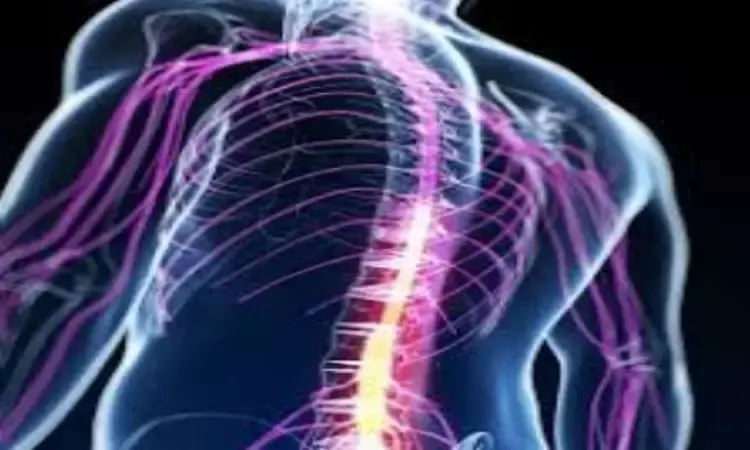- Home
- Medical news & Guidelines
- Anesthesiology
- Cardiology and CTVS
- Critical Care
- Dentistry
- Dermatology
- Diabetes and Endocrinology
- ENT
- Gastroenterology
- Medicine
- Nephrology
- Neurology
- Obstretics-Gynaecology
- Oncology
- Ophthalmology
- Orthopaedics
- Pediatrics-Neonatology
- Psychiatry
- Pulmonology
- Radiology
- Surgery
- Urology
- Laboratory Medicine
- Diet
- Nursing
- Paramedical
- Physiotherapy
- Health news
- Fact Check
- Bone Health Fact Check
- Brain Health Fact Check
- Cancer Related Fact Check
- Child Care Fact Check
- Dental and oral health fact check
- Diabetes and metabolic health fact check
- Diet and Nutrition Fact Check
- Eye and ENT Care Fact Check
- Fitness fact check
- Gut health fact check
- Heart health fact check
- Kidney health fact check
- Medical education fact check
- Men's health fact check
- Respiratory fact check
- Skin and hair care fact check
- Vaccine and Immunization fact check
- Women's health fact check
- AYUSH
- State News
- Andaman and Nicobar Islands
- Andhra Pradesh
- Arunachal Pradesh
- Assam
- Bihar
- Chandigarh
- Chattisgarh
- Dadra and Nagar Haveli
- Daman and Diu
- Delhi
- Goa
- Gujarat
- Haryana
- Himachal Pradesh
- Jammu & Kashmir
- Jharkhand
- Karnataka
- Kerala
- Ladakh
- Lakshadweep
- Madhya Pradesh
- Maharashtra
- Manipur
- Meghalaya
- Mizoram
- Nagaland
- Odisha
- Puducherry
- Punjab
- Rajasthan
- Sikkim
- Tamil Nadu
- Telangana
- Tripura
- Uttar Pradesh
- Uttrakhand
- West Bengal
- Medical Education
- Industry
Single leg Stance Duration sensitive and reliable marker of Measure of Neuromuscular Aging, finds study

Researchers found that the duration of single-leg stance was a sensitive and reliable age marker of neuromuscular aging among apparently healthy, asymptomatic populations aged 50 years or older. A recent study was published in PLoS One by Asghar R. and colleagues. The study aimed at exploring the effect of age on gait, balance, and strength and determined if there existed gender differences in these assessments.
This was a cross-sectional survey where healthy adults aged more than 50 years were recruited. Their physical function was evaluated across three core assessments: gait, balance, and strength. Measurements were taken on the dominant side of the body both on the upper extremities (grip) and on the lower extremities (knee). Balance was measured with a force plate, and static stability of four 30-second stance conditions, including bilateral stance while eyes were open, bilateral stance while eyes were closed and unipedal stances on both dominant and nondominant legs while their eyes were open. During level walking, gait for each participant was analyzed by determining dynamic stability margins and Z-scores were again used to determine the change with age on these values.
• Gait was relatively preserved by aging, and the p-value was nonsignificant indicating no significant changes (p≥0.12).
• Both grip strength and knee strength declined significantly with advancing age. The strength measure showed the smallest decline with each decade. Grip strength declined by -0.34 SDs, and the decline for knee strength was -0.26 SDs.
• All of the participants achieved steady bipedal balance, but the center of pressure movement was substantially increased with age (p≤0.028).
• Both stance durations for the non-dominant and dominant legs decreased with advancing age, and these declines were highly significant; however, the loss of stance duration by decade was more pronounced for the non-dominant leg than the dominant leg (-0.62 SDs vs -0.53 SDs respectively).
• Notable sex differences were identified only for strength measures, where males had higher grip and knee strength than females.
Unipedal stance time proves to be an appropriate and gender-insensitive indicator of neuromuscular aging having the strong perspective of potential application in the conduct of a geriatric health evaluation.As aging populations continue to grow, reliable assessments like unipedal stance can support proactive care and intervention, improving health outcomes and quality of life for older adults.
Reference:
Dr Riya Dave has completed dentistry from Gujarat University in 2022. She is a dentist and accomplished medical and scientific writer known for her commitment to bridging the gap between clinical expertise and accessible healthcare information. She has been actively involved in writing blogs related to health and wellness.
Dr Kamal Kant Kohli-MBBS, DTCD- a chest specialist with more than 30 years of practice and a flair for writing clinical articles, Dr Kamal Kant Kohli joined Medical Dialogues as a Chief Editor of Medical News. Besides writing articles, as an editor, he proofreads and verifies all the medical content published on Medical Dialogues including those coming from journals, studies,medical conferences,guidelines etc. Email: drkohli@medicaldialogues.in. Contact no. 011-43720751


